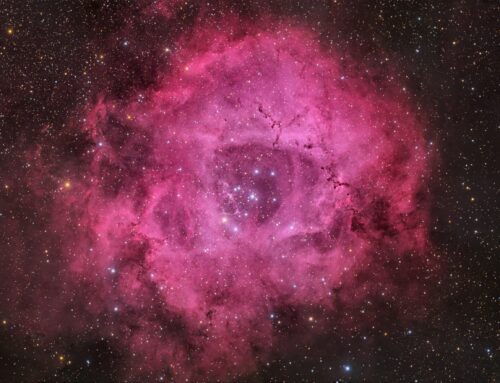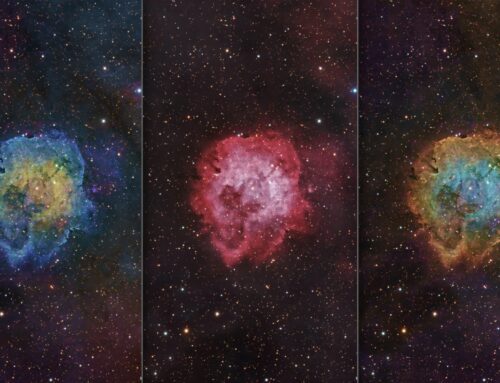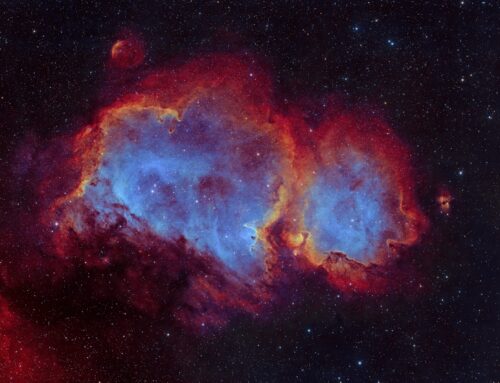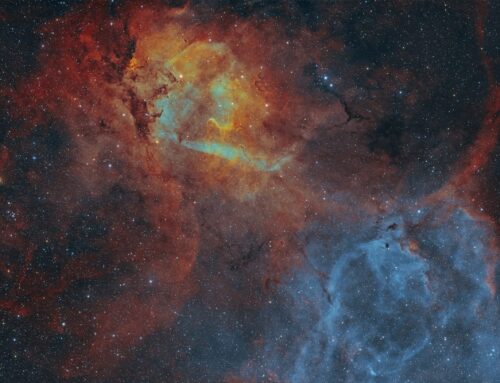NGC 7000 in SHO

Click image for full size version (31 MB – be patient)
September 13, 2025
NGC 7000 (also called the North America Nebula) dominates the left side of this image, and NGC 5070 (the Pelican Nebula) is to the right. These clouds of gas are part of a huge complex of emission nebulae lying about 1,600 light years away in northern Cygnus. With an apparent magnitude (brightness) of 4, in theory this object is visible to the naked eye, even though its light is very spread out. I have seen it with my naked eye and with low power binoculars in dark skies north of where I live. It looks like a faintly hazy, irregular patch of grey.
I have previously imaged this region in a wide field and at higher resolution. For example, you can find images of the Cygnus Wall (the “Central America” region) and the Pelican.
All but one of my prior images has been in natural broadband colour, dominated by red emissions of hydrogen. For this image I used two Optolong dual-narrowband filters designed for colour cameras. The Optolong L-eXtreme passes hydrogen and oxygen emissions; the brand-new L-Synergy filter passes sulphur and oxygen emissions. I combined the data from the two filters assigning sulphur to red, hydrogen to green, and oxygen to blue, making the traditional Hubble Palette. As you can see from the image, the filters worked great. It will be available for purchase soon. This is the first narrowband image made with the 70mm f/7 Sky-Watcher Esprit EDX refractor. Sky-Watcher hopes to have them available to buy by the end of 2025. Here is some preliminary information about the new Esprit EDX line.
Tekkies:
Acquisition, focusing, and control of Paramount MX mount and other equipment with N.I.N.A. and TheSkyX. Unguided. Focus with Primalucelab Sesto Senso 2 on the Sky-Watcher stock focuser. Equipment control with Primalucelab Eagle 4 Pro computer. All pre-processing and processing in PixInsight. Acquired from my SkyShed in Guelph. Acquired under average transparency and seeing and moderate to strong moonlight from August 31 – September 8, 2025.
Sky-Watcher Esprit 70 EDX refractor, QHY367C Pro camera.
L-Synergy Filter: 147 x 5m = 11hr 50m
L-eXtreme Filter: 140 x 5m = 11hr 40m
Total: 23hr 30m
Preprocessing: The WeightedBatchPreProcessing script was used to perform calibration, cosmetic correction, weighting, registration, local normalization, integration and Drizzle integration of all frames (Fast Drizzle, Scale=2x, Drop Shrink=0.9).
Gradient Removal: DynamicBackgroundExtraction was applied to the two masters (L-Synergy = SOO; L-eXtreme = HOO).
SHO Master Creation: PixelMath was used to create an SHO using the equations:
R=SOO[0]
G=HOO[0]
B=0.25 x (SOO[1] + SOO[2]+HOO[1] + HOO[2]
Deconvolution: BlurXterminator was applied to the SHO image using an automatic PSF, star sharpening set to 0.10, and “Correct First” selected.
Linear Noise Reduction: NoiseXterminator was applied with Amount=0.95 and Detail=0.5
Stretching: HistogramTransformation was applied to make a pleasing yet bright image. Approximate background level after stretch was 0.10
Nonlinear Processing
Star Removal: StarXterminator was used to remove the stars, with Unscreen selected
Nonlinear Noise Reduction: NoiseXterminator was applied with Amount=0.9 and Detail=0.25
Contrast Enhancement: HistogramTransformation was used to adjust brightness and black point. LocalHistogramEqualization was applied twice. A Contrast Limit of 1.5 and 1 iteration was used for each LHE application (scale 40, strength 0.25; scale 150, strength 0.28). ExponentialTransformation was applied (
Sharpening: A mask that selected just the brightest parts of the nebula was used with MultiscaleMedianTransform to sharpen Layers 2 – 5 with strengths of 0.03, 0.03, 0.03, and 0.02, respectively.
Contrast, Brightness and Colour Adjustment: Brightness, contrast, hue, and saturation were adjusted in several iterations using CurvesTransformation, ExponentialTransformation and the Jurgen Terpe Selective Color Correction script, with masks as required.
Star-only Processing: Magenta stars were corrected in three steps. 1) The stars-only image was inverted. 2) SCNR was applied. 3) The image was inverted back to its original state. The lightness was extracted from the stars-only image and used to make a mask. Colour in the stars was boosted through the mask with two applications of CurvesTransformation Saturation tool.
Star Restoration: PixelMath expression combine(starless, stars, op_screen()) was used to combine the starless and stars-only images.
Final Steps: Background, nebula and star brightness, contrast and saturation were adjusted in several iterations using CurvesTransformation with masks as required. The DarkStructureEnhance script was applied with an amount of 0.2. ICCProfileTransformation (sRGB IEC61966-2.1; Relative Colorimetric with black point compensation) was applied prior to saving as a jpg. The image was annotated with the AnnotateImage script. The finder chart was made using the FindingChart process.








Amazing shot Ron! Keep on truckin’.
Thanks for sharing your great work.
sg.